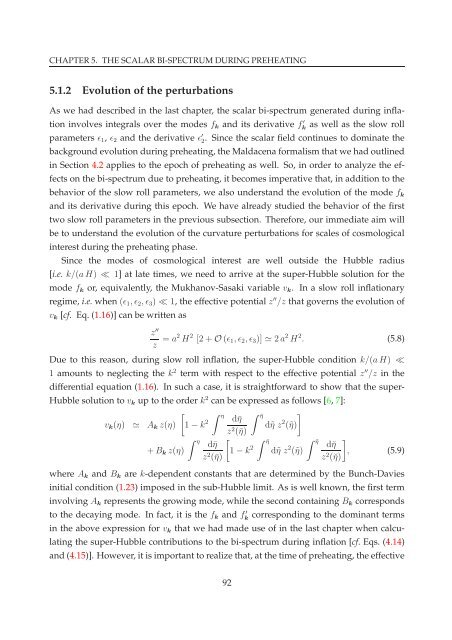PHYS08200605006 D.K. Hazra - Homi Bhabha National Institute
PHYS08200605006 D.K. Hazra - Homi Bhabha National Institute
PHYS08200605006 D.K. Hazra - Homi Bhabha National Institute
You also want an ePaper? Increase the reach of your titles
YUMPU automatically turns print PDFs into web optimized ePapers that Google loves.
CHAPTER 5. THE SCALAR BI-SPECTRUM DURING PREHEATING<br />
5.1.2 Evolution of the perturbations<br />
As we had described in the last chapter, the scalar bi-spectrum generated during inflation<br />
involves integrals over the modes f k and its derivative f k ′ as well as the slow roll<br />
parameters ǫ 1 , ǫ 2 and the derivative ǫ ′ 2 . Since the scalar field continues to dominate the<br />
background evolution during preheating, the Maldacena formalism that we had outlined<br />
in Section 4.2 applies to the epoch of preheating as well. So, in order to analyze the effects<br />
on the bi-spectrum due to preheating, it becomes imperative that, in addition to the<br />
behavior of the slow roll parameters, we also understand the evolution of the mode f k<br />
and its derivative during this epoch. We have already studied the behavior of the first<br />
two slow roll parameters in the previous subsection. Therefore, our immediate aim will<br />
be to understand the evolution of the curvature perturbations for scales of cosmological<br />
interest during the preheating phase.<br />
Since the modes of cosmological interest are well outside the Hubble radius<br />
[i.e. k/(aH) ≪ 1] at late times, we need to arrive at the super-Hubble solution for the<br />
mode f k or, equivalently, the Mukhanov-Sasaki variable v k . In a slow roll inflationary<br />
regime, i.e. when (ǫ 1 ,ǫ 2 ,ǫ 3 ) ≪ 1, the effective potential z ′′ /z that governs the evolution of<br />
v k [cf. Eq. (1.16)] can be written as<br />
z ′′<br />
z = a2 H 2 [2+O(ǫ 1 ,ǫ 2 ,ǫ 3 )] ≃ 2a 2 H 2 . (5.8)<br />
Due to this reason, during slow roll inflation, the super-Hubble condition k/(aH) ≪<br />
1 amounts to neglecting the k 2 term with respect to the effective potential z ′′ /z in the<br />
differential equation (1.16). In such a case, it is straightforward to show that the super-<br />
Hubble solution to v k up to the order k 2 can be expressed as follows [6, 7]:<br />
[ ∫ η<br />
∫<br />
v k (η) ≃ A k z(η) 1−k 2 d¯η ¯η<br />
d˜η z (˜η)]<br />
2<br />
z 2 (¯η)<br />
∫ η<br />
[ ∫<br />
d¯η ¯η ∫ ˜η<br />
]<br />
+B k z(η) 1−k 2 d˜η z 2 d˘η<br />
(˜η) , (5.9)<br />
z 2 (¯η)<br />
z 2 (˘η)<br />
where A k and B k are k-dependent constants that are determined by the Bunch-Davies<br />
initial condition (1.23) imposed in the sub-Hubble limit. As is well known, the first term<br />
involving A k represents the growing mode, while the second containing B k corresponds<br />
to the decaying mode. In fact, it is the f k and f k ′ corresponding to the dominant terms<br />
in the above expression for v k that we had made use of in the last chapter when calculating<br />
the super-Hubble contributions to the bi-spectrum during inflation [cf. Eqs. (4.14)<br />
and (4.15)]. However, it is important to realize that, at the time of preheating, the effective<br />
92
















